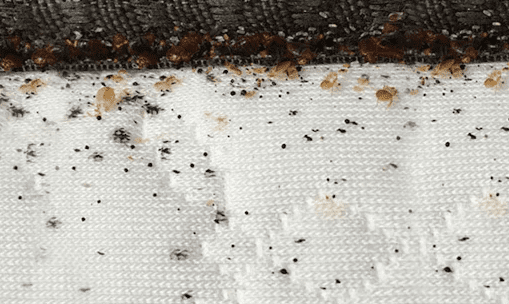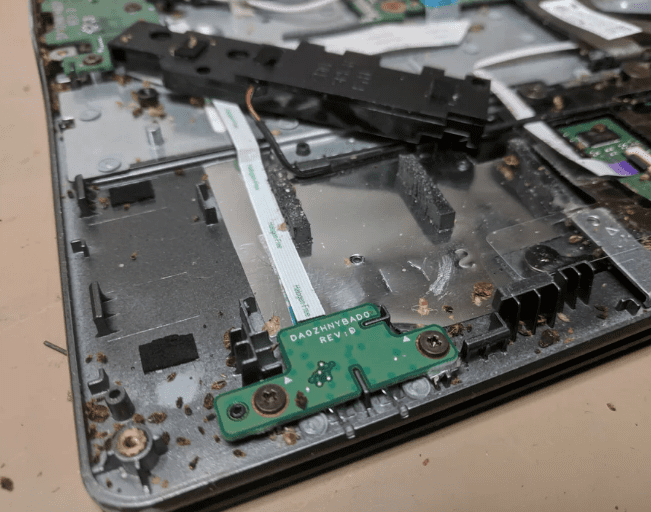Introduction
Understanding where bed bug eggs are typically found is crucial for effective pest control. These minuscule pests reproduce rapidly, with each female laying hundreds of eggs in her lifetime. Identifying and eliminating their eggs is fundamental to eradicating infestations. In this comprehensive guide, we’ll delve into the characteristics of bed bug eggs and explore the various hiding spots where they may lurk in your home. By gaining insight into their behavior and preferred habitats. You’ll be better equipped to combat these resilient insects and reclaim your living space. So, let’s embark on a journey to uncover the secret locations where bed bug eggs thrive. And arm ourselves with the knowledge needed to tackle these persistent pests head-on.
Source: EPA – Bed Bugs: Biology and Behavior
Characteristics of Bed Bug Eggs

Bed bug eggs possess distinct characteristics that set them apart from other debris. Typically, they are small, about the size of a pinhead, and translucent when freshly laid. As they mature, they darken in color, resembling tiny grains of rice. Their oval shape and sticky texture allow them to adhere to surfaces, making them challenging to remove. Understanding these traits is essential for effective identification during inspections. When conducting a thorough search for bed bug eggs, be on the lookout for their size, coloration, and adhesive properties. These features serve as key indicators of infestation severity and inform the appropriate course of action for eradication. By familiarizing yourself with the unique characteristics of bed bug eggs, you can enhance your ability to detect and address infestations promptly.
Source: University of Minnesota Extension – Bed Bugs
Common Hiding Spots for Bed Bug Eggs
Bed bug eggs are adept at concealing themselves in various nooks and crannies, making detection challenging. Knowing where to search is essential for thorough inspections and effective control measures. Here are some common hiding spots where bed bug eggs are frequently found:
- Mattresses and Box Springs: These are prime habitats for bed bugs and their eggs due to the proximity to their human hosts. Inspect seams and tufts thoroughly for signs of egg clusters. Additionally, check underneath mattress labels and tags, as bed bugs often seek refuge in these concealed areas.
- Furniture and Upholstery: Sofas, chairs, and other upholstered furniture provide ample hiding spots for bed bugs and their eggs. Pay close attention to cushions and seams where eggs may be nestled. Wooden furniture joints are also susceptible to infestation, as bed bugs can easily hide within the crevices.
- Cracks and Crevices in Walls: Bed bugs are skilled at squeezing into tight spaces, including cracks and crevices in walls. Check along baseboards and molding for evidence of egg deposits. Electrical outlets and switch plates are also common hiding spots, as bed bugs are attracted to warmth and darkness.
By meticulously inspecting these common hiding spots. You can increase the likelihood of detecting bed bug eggs and taking appropriate action to address the infestation promptly. Remember to use a flashlight and magnifying glass to aid in your search. As bed bug eggs can be challenging to spot with the naked eye.
Source: Pennsylvania State University – Bed Bug Biology and Behavior
Unconventional Hiding Spots for Bed Bug Eggs
While bed bugs often gravitate towards typical hiding spots like mattresses and furniture, they are also known to seek refuge in less expected areas. Being aware of these unconventional hiding spots is crucial for thorough inspections and effective pest control strategies. Here are some unconventional places where bed bug eggs may be lurking:
- Clothing and Personal Belongings: Bed bugs are notorious hitchhikers and can easily latch onto clothing and personal items. Inspect pockets, seams, and folds of clothing for signs of egg clusters. Additionally, check luggage and bags thoroughly, especially if you’ve recently traveled or encountered infested environments.

- Electronics and Appliances: Electronics and household appliances provide warm, secluded environments that bed bugs find appealing. Examine gaming consoles, computers, and televisions for any signs of egg deposition. Bed bugs may also hide in stereo systems and other electronic devices with small crevices.
By expanding your search beyond typical hiding spots, you can increase the chances of detecting bed bug eggs and preventing infestations from spreading. Utilize a combination of visual inspections and bed bug detection tools to thoroughly examine these unconventional areas for signs of activity.
Source: National Pesticide Information Center – Bed Bugs
How to Detect Bed Bug Eggs
Detecting bed bug eggs is a crucial step in effectively managing infestations and preventing their spread. While these eggs are tiny and often difficult to spot, there are several techniques you can employ to enhance your detection efforts. Here are some practical methods for detecting bed bug eggs:
- Visual Inspection Techniques: Conduct a thorough visual inspection of areas where bed bugs are known to hide, such as mattresses, furniture, and cracks in walls. Look for tiny, translucent eggs clustered together, usually in groups of 10-50.
- Using a Flashlight and Magnifying Glass: Utilize a flashlight to illuminate dark areas and a magnifying glass to examine them closely. Bed bug eggs are small and can easily go unnoticed without proper lighting and magnification.
- Utilizing Bed Bug Detection Tools: Consider using bed bug detection tools such as bed bug monitors and traps to aid in your search. These devices are designed to attract and capture bed bugs, including their eggs, providing valuable evidence of infestation.
By combining these detection methods, you can increase your chances of identifying bed bug eggs and taking appropriate action to address the infestation. Remember to be thorough and systematic in your inspections. As early detection is key to preventing bed bug populations from escalating.
Source: University of Kentucky Entomology – Bed Bugs
Preventive Measures Against Bed Bug Eggs
Implementing preventive measures is essential for reducing the risk of bed bug infestations and minimizing the likelihood of egg deposition in your home. By adopting proactive strategies, you can create an environment that is less hospitable to bed bugs and their eggs. Here are some preventive measures to consider:
- Regular Cleaning and Decluttering: Keep your home clean and clutter-free to eliminate potential hiding spots for bed bugs. Vacuum regularly, paying close attention to seams, cracks, and crevices where eggs may be deposited. Decluttering reduces the number of hiding places available to bed bugs, making it easier to detect and eliminate them.
- Encasing Mattresses and Box Springs: Invest in high-quality bed bug-proof mattress and box spring encasements to prevent bed bugs from infesting these areas. These encasements create a protective barrier that traps bed bugs and prevents them from accessing their preferred hiding spots.
- Vacuuming and Laundering Bedding: Regularly vacuum your bedding, including mattresses, box springs, and bed frames, to remove any bed bugs or eggs that may be present. Wash bedding, linens, and clothing in hot water and dry them on high heat to kill any bed bugs or eggs that may be hiding in fabrics.
By incorporating these preventive measures into your routine. You can reduce the risk of bed bug infestations and protect your home from these persistent pests. Remember to be vigilant and proactive in your efforts to prevent bed bug eggs from being deposited in your living space.
Source: Centers for Disease Control and Prevention – Bed Bugs
Treatment Options for Bed Bug Eggs
When dealing with bed bug infestations, effective treatment options are essential for eliminating both the insects and their eggs. Various methods exist for eradicating bed bugs and their eggs, ranging from chemical treatments to DIY remedies. Here are some treatment options to consider:
- Chemical Treatments: Chemical pesticides can be effective in killing bed bugs and their eggs when applied correctly. These treatments typically involve the use of insecticides that target bed bugs at various stages of their life cycle, including eggs. Professional exterminators may use residual insecticides, aerosols, or dust formulations to treat infested areas.
- Heat Treatments: Heat treatments are a non-chemical approach to eliminating bed bugs and their eggs. This method involves raising the temperature of infested areas to levels lethal to bed bugs, typically around 120-140°F. Specialized equipment, such as portable heaters or steamers, can conduct heat treatments to ensure thorough coverage of infested areas.
- DIY Remedies and Natural Solutions: Some individuals may opt for DIY remedies and natural solutions to combat bed bug infestations. These may include the use of essential oils, diatomaceous earth, or homemade insecticidal sprays. While these methods may offer some degree of control, they are often less effective than professional treatments and may require repeated applications.
When choosing a treatment option, it’s crucial to consider several factors. First, assess the severity of the infestation. Additionally, take into account the presence of sensitive individuals or pets in your household. Furthermore, consider your personal preferences regarding chemical exposure. Moreover, it’s vital to follow label instructions meticulously. Finally, if necessary, seek professional assistance to guarantee the safe and effective eradication of bed bugs and their eggs.
Source: National Institute of Environmental Health Sciences – Bed Bugs
Conclusion
In conclusion, understanding the location of bed bug eggs is crucial for effective pest management and prevention. By acquainting yourself with the characteristics of bed bug eggs and conducting thorough inspections of common and unconventional hiding spots, you can detect infestations early and take prompt action. Moreover, implementing preventive measures such as regular cleaning, encasing mattresses, and laundering bedding can help reduce the risk of infestations and minimize egg deposition. Furthermore, exploring treatment options, ranging from chemical treatments to DIY remedies, can aid in eradicating bed bugs and their eggs effectively. It’s important to note that early detection and proactive measures are essential for mitigating the impact of bed bug infestations and maintaining a pest-free environment.
For further information on bed bug prevention, detection, and treatment, consider exploring the following additional resources:
1. Environmental Protection Agency – Bed Bugs: Provides comprehensive information on bed bug biology, behavior, and control strategies.
2. Centers for Disease Control and Prevention – Bed Bugs: Offers guidance on identifying and managing bed bug infestations, as well as tips for travelers.
3. University Extension Services: Many university extension services offer valuable resources and fact sheets on bed bug biology, prevention, and control.
By leveraging these resources and implementing best practices, you can effectively combat bed bug infestations and safeguard your home and belongings against these persistent pests.




